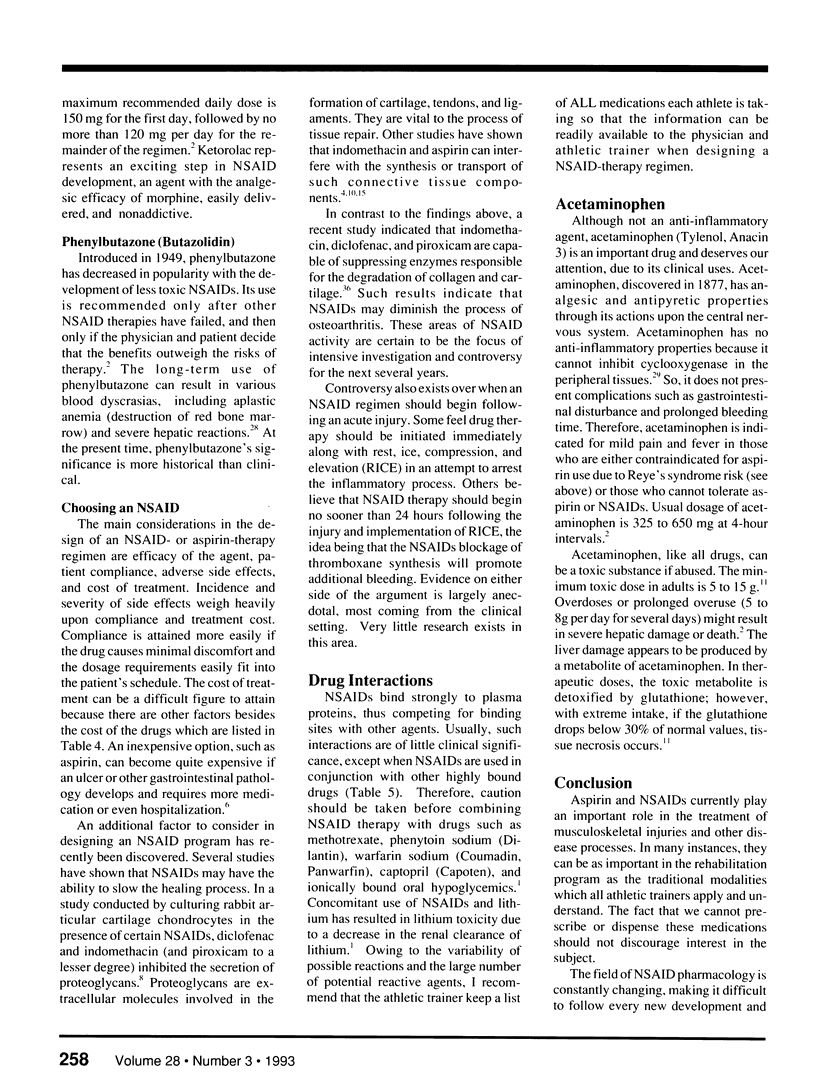Abstract
In this article, I present an overview of the actions and effects of aspirin and nonsteroidal anti-inflammatory drugs (NSAIDs). Although athletic trainers cannot prescribe or dispense prescription medications, they should be as aware of their effects as they are of other methods of injury treatment. To set the discussion in proper perspective, the inflammatory process and its mediators are reviewed briefly. The eicosanoids are a family of very active chemicals, which include: the prostaglandins, thromboxane, and the leukotrienes. They affect inflammation as well as numerous other body processes. Ingesting aspirin and NSAIDs blocks the production of prostaglandins and thromboxane, resulting in desired and undesired effects. The NSAIDs were developed to have the same action as aspirin, but with fewer adverse side effects. Many NSAIDs are currently available, and the decision as to which agent to use depends upon various factors. Surprisingly, recent studies suggest that some NSAIDs may hinder the healing process. Although not a NSAID, acetaminophen has many important clinical uses. Armed with an understanding of how these drugs act, and their potentially harmful aspects, the athletic trainer can assist the team physician in designing an aspirin- or NSAID-therapy regimen.
Full text
PDF






Selected References
These references are in PubMed. This may not be the complete list of references from this article.
- Bassleer C., Henrotin Y., Franchimont P. Effects of sodium naproxen on differentiated human chondrocytes cultivated in clusters. Clin Rheumatol. 1992 Mar;11(1):60–65. doi: 10.1007/BF02207086. [DOI] [PubMed] [Google Scholar]
- Collier S., Ghosh P. Comparison of the effects of non-steroidal anti-inflammatory drugs (NSAIDs) on proteoglycan synthesis by articular cartilage explant and chondrocyte monolayer cultures. Biochem Pharmacol. 1991 May 1;41(9):1375–1384. doi: 10.1016/0006-2952(91)90111-h. [DOI] [PubMed] [Google Scholar]
- Dajani E. Z., Wilson D. E., Agrawal N. M. Prostaglandins: an overview of the worldwide clinical experience. J Assoc Acad Minor Phys. 1991;2(1):23, 27-35. [PubMed] [Google Scholar]
- David M. J., Vignon E., Peschard M. J., Broquet P., Louisot P., Richard M. Effect of non-steroidal anti-inflammatory drugs (NSAIDS) on glycosyltransferase activity from human osteoarthritic cartilage. Br J Rheumatol. 1992;31 (Suppl 1):13–17. [PubMed] [Google Scholar]
- Henrotin Y., Bassleer C., Franchimont P. In vitro effects of Etodolac and acetylsalicylic acid on human chondrocyte metabolism. Agents Actions. 1992 Jul;36(3-4):317–323. [PubMed] [Google Scholar]
- Lovejoy F. H., Jr, Smith A. L., Bresnan M. J., Wood J. N., Victor D. I., Adams P. C. Clinical staging in Reye syndrome. Am J Dis Child. 1974 Jul;128(1):36–41. doi: 10.1001/archpedi.1974.02110260038007. [DOI] [PubMed] [Google Scholar]
- Nuki G. Non-steroidal analgesic and anti-inflammatory agents. Br Med J (Clin Res Ed) 1983 Jul 2;287(6384):39–43. doi: 10.1136/bmj.287.6384.39. [DOI] [PMC free article] [PubMed] [Google Scholar]
- O'Hara D. A., Fragen R. J., Kinzer M., Pemberton D. Ketorolac tromethamine as compared with morphine sulfate for treatment of postoperative pain. Clin Pharmacol Ther. 1987 May;41(5):556–561. doi: 10.1038/clpt.1987.71. [DOI] [PubMed] [Google Scholar]
- Oates J. A., FitzGerald G. A., Branch R. A., Jackson E. K., Knapp H. R., Roberts L. J., 2nd Clinical implications of prostaglandin and thromboxane A2 formation (2). N Engl J Med. 1988 Sep 22;319(12):761–767. doi: 10.1056/NEJM198809223191206. [DOI] [PubMed] [Google Scholar]
- Whitehill W. R., Wright K. E., Robinson J. B. Guidelines for dispensing medications. J Athl Train. 1992;27(1):20–22. [PMC free article] [PubMed] [Google Scholar]
- Yee J. P., Koshiver J. E., Allbon C., Brown C. R. Comparison of intramuscular ketorolac tromethamine and morphine sulfate for analgesia of pain after major surgery. Pharmacotherapy. 1986 Sep-Oct;6(5):253–261. doi: 10.1002/j.1875-9114.1986.tb03485.x. [DOI] [PubMed] [Google Scholar]


